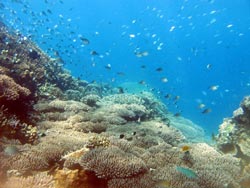Simulation Model Provides Information on the Future of Reefs

Relatively undisturbed reef in Zanzibar<br>A. Kubicek, ZMT <br>
To address this key question, ecologists of the Leibniz Center for Tropical Marine Ecology (ZMT) in Bremen developed a simulation model showing the development of a virtual reef under the influence of some of the most common perturbation factors – with surprising results!
Real-world reefs off the coast of Zanzibar with their most common coral and algae species were the basis for the simulation model. These coral reefs fringe large parts of the coast there and are popular diving areas for the growing tourism industry. However, the fragile reef ecosystems suffer significantly from human intervention. Anchors dropped from tourist boats cause great damage to the top of the reef. The local population meets the increasing demand for fresh fish with destructive fishing methods. Large trawl nets or even dynamite are often used for fishing. Coral material is often extracted as substitute for cement to build houses.
In the simulation model, the Bremen researchers can expose the virtual reefs to such perturbations and study how they develop under pressure over periods of many decades. “The simulation shall provide a basis for decisions in coastal management,” says Andreas Kubicek, who developed the model as part of his doctoral thesis. “You can select the perturbation factors and then see how some coral species die off and other species spread, or eventually how algae win the upper hand in the reef.” Extensive data on the growth, proliferation and interaction between the reef organisms, which were collected from reefs around the world, went into the development of the program.
The researchers tested their reef model on the basis of a special event. In 1998 the El Niño climate phenomenon struck with exceptional impact across the globe. Around Zanzibar the seawater temperature rose from an average of 27 °C to a high of 32 °C. As a consequence, many corals bleached and the coral cover declined in some reefs from 60 % to only 20 %. Colleagues of the Institute of Marine Sciences on Zanzibar, a research partner of the ZMT, documented the development of the reef over a period of ten years. “We allowed a correspondingly intensive coral bleaching to impact our virtual reef,” said Hauke Reuter of the Department of Ecological Modelling at the ZMT. “We then monitored the results. Remarkably, exactly the same processes played out in the simulated reef“.
In the simulation the researchers also observed that in an undisturbed reef the more resistant species such as massive corals prevail and that species diversity is lost in the long term. Studies on the Great Barrier Reef recently confirmed this. The modellers were particularly surprised, however, that a disturbed reef can make a notable recovery under favourable conditions – up to a certain point. “At present, coral bleaching takes place every 10 to 12 years,” Reuter added. “Researchers predict for the future, however, that due to climate change coral bleaching is expected to take place every 4 to 5 years. According to our model, no reef will be able to survive this.”
Here the ZMT presents a simplified version of the model for the general public. You can select the different perturbation factors yourself and observe how the reef develops: http://www.zmt-bremen.de/en/The_Reef_Model.html
Publication:
Kubicek, A., Muhando, C., Reuter, H. (2012) Simulations of long-term community dynamics in coral reef – How perturbations shape trajectories. PLOS Computational Biology, 8(11). DOI: 10.1371/journal.pcbi.1002791.
Further information:
Dr. Andreas Kubicek
Phone: +49(0)421 / 23800-158
andreas.kubicek@zmt-bremen.de
Dr. Hauke Reuter
Phone: +49(0)421 / 23800-58
hauke.reuter@zmt-bremen.de
Media Contact
More Information:
http://www.zmt-bremen.de/en/The_Reef_Model.htmlAll latest news from the category: Ecology, The Environment and Conservation
This complex theme deals primarily with interactions between organisms and the environmental factors that impact them, but to a greater extent between individual inanimate environmental factors.
innovations-report offers informative reports and articles on topics such as climate protection, landscape conservation, ecological systems, wildlife and nature parks and ecosystem efficiency and balance.
Newest articles

Superradiant atoms could push the boundaries of how precisely time can be measured
Superradiant atoms can help us measure time more precisely than ever. In a new study, researchers from the University of Copenhagen present a new method for measuring the time interval,…

Ion thermoelectric conversion devices for near room temperature
The electrode sheet of the thermoelectric device consists of ionic hydrogel, which is sandwiched between the electrodes to form, and the Prussian blue on the electrode undergoes a redox reaction…

Zap Energy achieves 37-million-degree temperatures in a compact device
New publication reports record electron temperatures for a small-scale, sheared-flow-stabilized Z-pinch fusion device. In the nine decades since humans first produced fusion reactions, only a few fusion technologies have demonstrated…





















